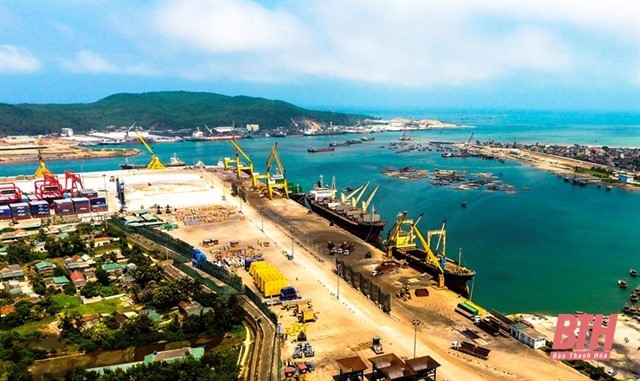Additional resources should be invested to develop the Nghi Sơn Port, located in the northern province of Thanh Hóa, to fully unlock the region’s industrial and economic potential, said the provincial government.

Additional resources should be invested to develop the Nghi Sơn Port, located in the central province of Thanh Hóa, to fully unlock the region’s industrial and economic potential, said the provincial government.
They said while the port has met current demands for the transport of goods and materials, it should be further expanded into a logistics centre including multiple warehouses and preservation facilities. According to the provincial government, this should be made a top priority as the port has become a key part of the province’s industrial network, import-export activities and production in the Nghi Sơn Economic Zone.
To date, a VNĐ25 trillion investment package to further develop the port has been approved, providing funding for 14 infrastructure projects, aiming to build as many as 21 general cargo terminals. Of which, 12 have been completed and put to work, capable of servicing vessels of up to 70,000DWT, including two terminals of PTSC Thanh Hóa Petroleum Service Joint Stock Company, three terminals of Đại Dương Investment Minerals Corporation, five terminals of VAS Nghi Sơn Corporation, one terminal of Quang Trung Limited Liability Company and one terminal of GAMA Thanh Hóa Chemical Joint Stock Company.
In addition, the port will house as many as 18 terminals to handle specialised cargo. Of which, 12 have been completed so far, servicing large-scale operations in the Nghi Sơn Economic Zone, including the Nghi Sơn Oil Refinery Plant, one terminal for the Nghi Sơn Cement Plant, and three terminals for the Nghi Sơn thermal power plants 1 and 2.
Meanwhile, the container port facility houses up to ten terminals, with four terminals approved for further investment under the VAS Nghi Sơn Corporation and four terminals under the Long Sơn Limited Liability Company.
At the same time, at the North Nghi Sơn area, the Đại Dương Investment Minerals Corporation has been working on survey for an area of approximately 557.197 hectares, which can be developed to increase cargo handling capacity of about 25 million tonnes per year with an investment amount of VNĐ14.1 trillion.
The port’s authority has also been working around the clock to improve its operational capacity. Two berthing and transhipment areas of Nghi Sơn Technical Services Limited Liability Company have been put into operation, capable of receiving vessels with a capacity of over 80,000DWT.
In addition, the Single Point Mooring (SPM) buoy of the Nghi Sơn Oil Refinery Plant can accommodate vessels up to 320,000DWT to handle crude oil imports with a capacity of 10 million tonnes per year.
Four berthing and transhipment points were serving the Nghi Son Thermal Power Plant 2, capable of receiving vessels up to 210,000DWT. In an earlier development, the Ministry of Transport (MoT) approved the investment policy for a project to upgrade maritime traffic to the terminals in the South Nghi Sơn area with a total investment of VNĐ567 billion.
The provincial government has proposed a plan to dredge for ship passages from Buoy number 0 to the port. The passage has been estimated to run for nearly seven kilometres and may cost up to VNĐ2.2 trillion. Of the total, VNĐ1.6 trillion will be sourced from Japan’s ODA and the rest from the province’s budget.
In the last two years, the province has also started an incentive programme for all vessels going through the port with up to VNĐ500 million per container on international trip, support of VNĐ2 million per 20-foot container and VNĐ3 million per 40-foot container as well as expedited customs declarations by Thanh Hóa Customs.
As a result, two international container shipping lines, namely the CMA-CGM Vietnam Joint Stock Company and VIMC Shipping Company, have completed as many as 44 international container trips since 2019, despite a period of low activity during the COVID-19 pandemic. Since the beginning of the year, the port reported six trips, operated by CMA-CGM.
Last year, there were 12,220 containers through the port, 7,293 containers exported and 4,927 containers imported, with the main export items including white powder, virgin plastic pellets, cassava slices, and cardboard. — VNS
- Tags
- Nghi Sơn Port






